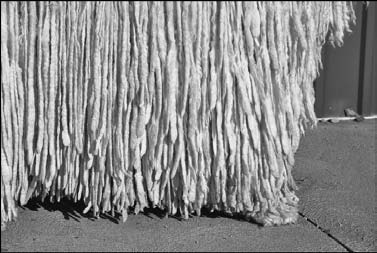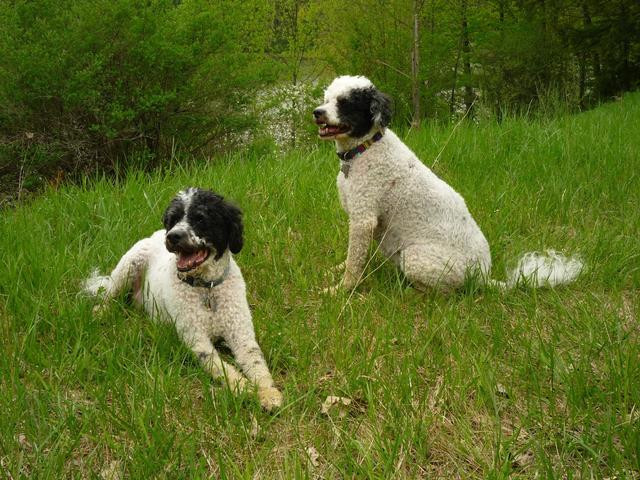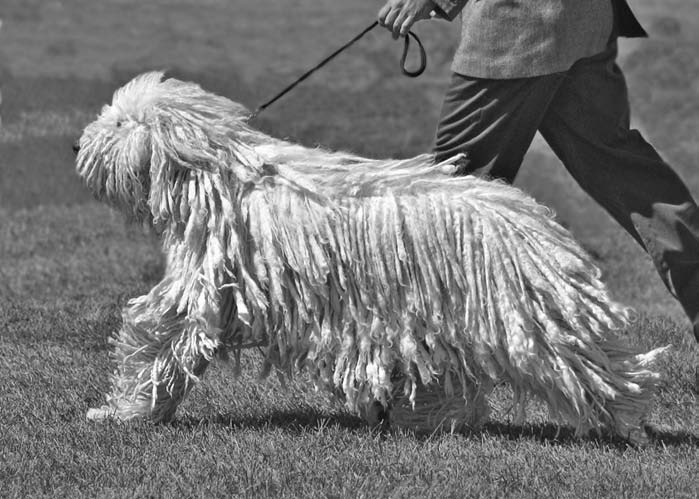- Discovering the corded breeds
- Developing those doggie dreadlocks
- Bathing (and drying) the corded canine coiffure
- Preparing your corded dog for show
If you’ve never seen a corded dog, the first time you run into one you’re likely to think that you’ve met up with a mop with four feet, a wet nose, and a tail. But make no mistake about it, these dogs are cool to watch and look fabulous when their coats are in full cords.
Cords on these breeds form naturally. The undercoats naturally entwine with the top coat, creating a type of cording or felting (another fancy name for cording). The cords usually begin to form when the puppy is shedding out his puppy coat and growing in his adult coat at 9 months or thereabouts. Depending on the breed, cords can take from two to five years to mature. During this maturation process, owners of corded dogs need to make sure that their pups’ coats don’t form mats and instead separate into cords.
Most owners choose these dogs because of the distinctive look the cords have, plus they love the personalities of the corded dogs. If you have a corded dog, chances are you want to keep the cords in as good of shape as possible and keep them long. Ultimately that means you need to encourage a show-type coat, which requires a considerable amount (almost daily) of maintenance. Lucky for you, this chapter explains everything you need to know about grooming your dog’s corded coat to keep it looking its very best.
Introducing the Corded Breeds
So you’ve never seen a four-legged, wet-nosed mop, eh? Well, take a look at the Komondor in Figure 10-1, who is joined by four other breeds on the corded list:
- Bergamasco
- Corded Poodle (Poodles can be shown with corded coats)
- Komondor
- Puli
- Spanish Water Dog
Corded dogs are water dogs or herding dogs, primarily because their corded coats provide good protection against the elements.
Figure 10-1: Yah mahn! The Komondor, he’s got the best of canine dreads.
Brushing
Until your puppy starts developing cords, brushing and combing are imperative for keeping your uncorded puppy looking good.
Caring for the coat before cords form
You need to brush and comb your puppy every day before the cords form. That’s the reality of the breed.
Without cords, corded puppies need to be brushed and combed the same way you would any other dog with curly hair. Here’s how:
The tricky part is telling a mat from a forming cord. If the hair is trying to form longwise, it’s a cord; otherwise it’s a mat and needs to be detangled.
2. Backbrush, or brush against the lay of your dog’s hair, first using a slicker brush and then again with a medium- or coarse-toothed comb — depending on the thickness and length of your dog’s coat.
Using a slicker brush removes the loose hairs, and using a comb helps you make sure no tangles are present and removes more hair.
3. Brush your dog’s coat with the lay of the hair using a slicker brush.
Be sure to get all the way to the skin as you brush your dog this way.
4. Go over your dog’s coat with a flea comb to detangle any mats and to look for fleas.
You can best use a flea comb by parting the coat, starting at the root, and combing through.
5. Depending on how hairy your dog’s pads are, you can either leave them natural or clip them by running electric clippers with a No. 10 blade over the paw pads to remove any excess hair.
Don’t clip the hair between the pads — just any excess that otherwise may get in the way or inhibit a neater appearance.
6. If you wish, use a No. 10 blade to trim around the anal area and belly to avoid a mess.
As the cords form
At some point, your puppy’s coat is going to start forming cords (see Figure 10-2). They usually begin to form at the skin first as the puppy starts shedding his puppy fluff, and the coat begins to mature.
After the cords start forming, you need to separate them from the other hair with your fingers to make sure that they don’t form mats. Separating the cords is a daily task together with brushing out any other hair that hasn’t yet become part of a cord with a slicker brush and a comb. Cords form pretty much on their own – it just happens; you can’t do much to stop the process or encourage it.
Figure 10-2: Here’s what you may start with — a Puli pup before cords have fully formed.
As you might expect, mats and tangles are common with corded dogs until the cords form. After all, that’s how the cords are formed — sort of. If you think about it, cords are just elongated pieces of twisted hair that clump together, almost exactly as a mat would, except that they form a cord instead. If you find a smaller mat that isn’t cording, you can try to remove it by using detangler solution and a comb to gently tease it out, but you may have to use your fingers to get between the hairs and untangle them. After you do, you can try to separate the cords again and encourage them to stay corded. If the mat is seriously large, the best thing to do is consult a professional groomer to help you remove it.
Tip
Be patient with the cording process. It usually takes several years and daily grooming to coax the cords to mature properly. The coats of most corded breeds will cord naturally, but the fur still needs your help to prevent it from forming mats and terrible tangles rather than cords.
Maintaining healthy cords
If you’ve been a conscientious corded-breed owner, you’ve been separating cords so that they don’t become entangled. At some point, nothing is left but cords (see Figure 10-3). Now that your corded dog has a mature coat, I’m sure you’re wondering: “What do I do with the cords now?”
Figure 10-3: Body (a) and paw (b) cords close up.
After the cords form, your main responsibility becomes keeping the cords separated and free from dirt and debris. That’s no minor task for any kind of mop-like object or being. (If you don’t keep the cords clean, you end up with the kind of horrible mess that only clippers can solve.)
Put away the brush and comb and break out your clippers, pH-balanced shampoo, and conditioner — the basic tools you need to keep a corded dog clean and looking good.
You can use the clippers or scissors (remember to be careful) to trim away fuzzies that form on the ends of the cords and keep them neat and tidy. Trimming the cords also makes sure that the dirt these dogs naturally pick up off the floor doesn’t cause mats. Many pet owners prefer to have their dog’s underside and the area around the genitals and anus clipped to avoid obvious problems.
Tip
If you decide that cords are too much of a hassle (as many pet owners have), you can keep the cords trimmed back to about four inches, thus keeping them off the ground. In extreme cases, you can clip your dog’s cords back to whatever length you feel comfortable maintaining.
Keeping Cords Clean
The best way to keep your corded dog clean is to keep him away from the stuff that gets him dirty to begin with. But that means keeping him from being what he really is — a dog. You can expect a corded coat to pick up an extraordinary amount of dirt and debris that definitely requires thorough cleaning. Yes, corded breeds do need to be bathed, so in the sections that follow, I tell you how.
How often and when, really?
Corded dogs need to be bathed frequently to keep the cords clean and to maintain a healthy skin and coat. You may have to bathe your corded dog as often as once a week. If your dog can stay clean, you maybe can get by with bathing only once every other week. It just depends.
Remember
Bath time for corded dogs can be a lengthy ordeal — not because of washing, per se, but rather because of drying. Think in terms of hours when it comes to washing and drying a corded dog. Your arms will hurt, your dog will get bored, and you’ll start dreaming of dogs with no coats. An entire afternoon or morning may work — figure an hour to wash and two to three hours to dry.
Bathing basics
No one part of bathing a corded breed is tougher than the other. They all present unique problems that the corded breed owner must overcome. Getting the dog completely wet, completely washed and conditioned, completely rinsed, and then completely dried are what make bathing a corded dog really tough.
Warning!
Never wash a corded dog outside or in a dirty room. You end up undoing all that you’ve done to wash your dog.
Here are the steps to follow when washing your dog’s corded coat:
1. Wet down your dog thoroughly in a tub that’s an appropriate size for your breed of dog.
Accomplishing this task can be rough. Those cords can sop up a lot of water, and soaking your dog down to the skin may prove to be harder and more time consuming than you think.
Tip
Use a shower spray attachment or even fill a container and pour water from it into the cords then feel the skin and the cords to make sure they’re soaking wet.
2. Using a pH-balanced shampoo, thoroughly lather up your dog’s entire coat.
You need to make sure that the shampoo penetrates the cords by squeezing the suds into each one.
3. Starting from the skin and working outward to ensure that you leave no residue, thoroughly rinse the shampoo from the corded dog’s coat.
Tip
Always rub your hands through your dog’s cords down to the skin and through the cords again to rinse shampoo residue away. You must run clean water through each of the cords to make sure they’re totally rinsed.
Warning!
Rinsing your corded dog’s coat is extremely important, because leaving any residues in it is likely to result in a very dirty dog in a very short time. Dirt in the cords likewise can trap water and other nasty stuff, making them perfect breeding grounds for bacteria and mildew.
4. Repeat Steps 2 and 3, but this time in place of shampoo, apply a good conditioner to keep the cords feeling their best.
5. Rinse the conditioner from the corded coat really well (in the same way described in Step 3).
6. Dry your dog’s corded coat (check out the next section).
Drying the cords
Now that you’ve washed your corded dog, you must take these steps in the daunting process of drying your dog’s dreads:
1. Gently twist handfuls of cords in a wringing motion to remove the excess water while the dog is still in the tub.
Repeat this step on all of the cords, starting from the top of your dog and working your way down.
If the excess water is too soapy, rinse the cords again.
Wring the cords out several times until you can’t get any more water out.
2. Using towels, squeeze the water out of each cord down to the skin.
Take this step while your dog is still in the tub.
Pining over towel-dry-and-go dogsWhenever you’ve had to spend hours drying your corded dog, you’re probably thinking that a bald dog might be the way to go. All righty then: Although these dogs must be bathed weekly, drying them is a breeze: - American Hairless Terrier
- Chinese Crested
- Hairless Khala
- Peruvian Inca Orchid
- Xoloitzcuintli
|
3. Remove your dog from the tub and repeat Step 2 using dry towels.
4. Using a strong dog hair dryer without heat, blow-dry the corded coat from the skin outward.
Dry the cords in layers from the top to the bottom of the dog.
Remain patient. Drying a corded dog’s coat takes an extraordinary amount of time.
Warning!
Remember to thoroughly dry your dog; otherwise, he will mildew — yuk! If your dog smells like rotting vegetation or his coat turns odd colors and smells of mold or mildew, it’s time to clip the cords. Depending on how bad the mildew problem is, you may have to trim only a small section, or it may end up being the entire coat. If the entire coat is involved, I recommend seeking help from a professional groomer and a veterinarian. If the mildew isn’t too bad, you can try a medicated antifungal shampoo on your dog — which may get rid of the problem, but you must make sure your dog is completely dry to avoid the possibility of the mildew coming back.
Tip
Now that you know what bathing a corded dog entails, if you’re dead set on allowing your dog to play outside, either clip the cords back or provide your pooch with some kind of doggiewear that keeps most of the offending brush and dirt out of his coat.
Preparing for Show
If you’re thinking about entering your corded breed in the big show, a thorough understanding of the breed standard helps immensely. A good place to look for breed standards is on the Internet at
www.akc.org.
Here are some basic preparations that are essential:
- Trimming toenails
- Trimming frayed cords
- Bathing the dog
- Drying the dog
- Keeping the dog clean
The last two items are probably the most daunting of tasks where the corded dog is concerned. You might find it helpful to ask people who show corded breeds what grooming tips and tricks they recommend and then experiment to establish your own show routine.
by Margaret H.Bonham










